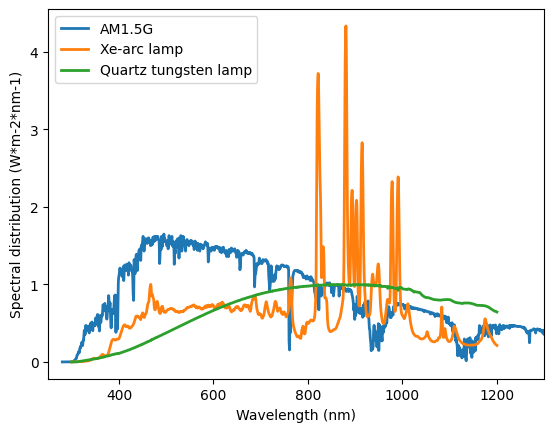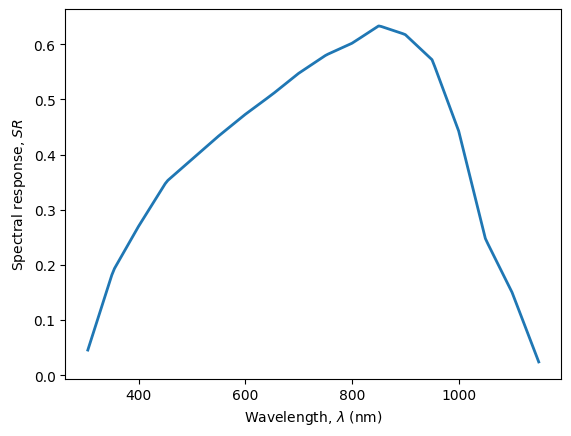Problem 12.7#
Fundamentals of Solar Cells and Photovoltaic Systems Engineering
Solutions Manual - Chapter 12
Problem 12.7
Using the QE of a silicon solar cell, calculate the photogenerated current density \(J_L\) under the reference spectrum AM1.5G and compare it to the \(J_L\) obtained from irradiance spectra produced by a Xe-arc lamp and a quartz tungsten halogen lamp. Then, calculate the error produced using a solar simulator based on Xe-arc or quartz tungsten lamps. The tabulated spectra and QE are provided in the online repository of this book.
Note that the error may be large because the Xe-arc and the quartz W halogen lamps are not placed at the right distance from the measuring plane. Let us assume that the spectral irradiance of the two lamps decreases homogeneously by 1% throughout the whole wavelength range for each cm of separation that is added between the lamp and the measuring plane. How far should each lamp be located with respect to the initial position to produce the same \(J_L\) that the AM1.5G solar?
We will use the package pandas to handle the data and matplotlib.pyplot to plot the results.
import pandas as pd
import numpy as np
import matplotlib.pyplot as plt
We start by importing the data for the solar spectra.
reference = pd.read_csv('data/Reference_spectrum_ASTM-G173-03.csv', index_col=0, header=0)
reference
| AM0 | AM1.5G | AM1.5D | |
|---|---|---|---|
| Wvlgth nm | Etr W*m-2*nm-1 | Global tilt W*m-2*nm-1 | Direct+circumsolar W*m-2*nm-1 |
| 280 | 8.20E-02 | 4.73E-23 | 2.54E-26 |
| 280.5 | 9.90E-02 | 1.23E-21 | 1.09E-24 |
| 281 | 1.50E-01 | 5.69E-21 | 6.13E-24 |
| 281.5 | 2.12E-01 | 1.57E-19 | 2.75E-22 |
| ... | ... | ... | ... |
| 3980 | 8.84E-03 | 7.39E-03 | 7.40E-03 |
| 3985 | 8.80E-03 | 7.43E-03 | 7.45E-03 |
| 3990 | 8.78E-03 | 7.37E-03 | 7.39E-03 |
| 3995 | 8.70E-03 | 7.21E-03 | 7.23E-03 |
| 4000 | 8.68E-03 | 7.10E-03 | 7.12E-03 |
2003 rows × 3 columns
reference.drop(reference.index[0], inplace=True) # remove row including information on units
reference=reference.astype(float) # convert values to float for easy operation
reference.index=reference.index.astype(float) # convert indexes to float for easy operation
We import the data for the Xe-arc lamp.
xe_arc = pd.read_csv('data/Xe lamp spectral irradiance.csv', index_col=0, header=0)
xe_arc
| Xe arc lamp (W*m-2*nm-1) | |
|---|---|
| wavelength (nm) | |
| 300.36966 | 0.000793 |
| 300.58005 | 0.000816 |
| 300.79044 | 0.000837 |
| 301.00082 | 0.000858 |
| 301.21124 | 0.000876 |
| ... | ... |
| 1199.77246 | 0.213920 |
| 1199.84302 | 0.213600 |
| 1199.91345 | 0.213280 |
| 1199.98401 | 0.212960 |
| 1200.05444 | 0.212640 |
6283 rows × 1 columns
We import the data for the quartz tungsten lamp.
quartz_w = pd.read_csv('data/W lamp spectral irradiance.csv', index_col=0, header=0)
quartz_w
| W halogen lamp (W*m-2*nm-1) | |
|---|---|
| wavelength (nm) | |
| 300 | 0.000001 |
| 301 | 0.000010 |
| 302 | 0.000100 |
| 303 | 0.000200 |
| 304 | 0.000300 |
| ... | ... |
| 1196 | 0.654304 |
| 1197 | 0.653941 |
| 1198 | 0.651544 |
| 1199 | 0.647531 |
| 1200 | 0.644677 |
901 rows × 1 columns
We can also plot the AM1.5G spectra, the Xe-arc lamp, and the quarz tungsten lamp spectra.
plt.plot(reference['AM1.5G'],
linewidth=2, label='AM1.5G')
plt.plot(xe_arc,
linewidth=2, label='Xe-arc lamp')
plt.plot(quartz_w,
linewidth=2, label='Quartz tungsten lamp')
plt.ylabel('Spectral distribution (W*m-2*nm-1)')
plt.xlabel('Wavelength (nm)')
plt.xlim([250,1300])
plt.legend()
<matplotlib.legend.Legend at 0x7f7ac5697d10>

We define the relevant constants and import the QE of the silicon solar cell.
h=6.63*10**(-34) # [J·s] Planck constant
e=1.60*10**(-19) # [C] electron charge
c =299792458 #[m/s] Light speed
QE = pd.read_csv('data/QE_Silicon.csv', index_col=0, header=0)
QE
| QE Silicon Solar cell | |
|---|---|
| nm | |
| 305 | 0.185579 |
| 310 | 0.243200 |
| 315 | 0.298992 |
| 320 | 0.353041 |
| 325 | 0.405425 |
| ... | ... |
| 1130 | 0.081951 |
| 1135 | 0.067769 |
| 1140 | 0.053712 |
| 1145 | 0.039777 |
| 1150 | 0.025964 |
170 rows × 1 columns
We calculate the Spectral Response (SR) of the silicon solar cell and plot it.
SR=pd.Series(index=QE.index,
data=[QE.loc[i,'QE Silicon Solar cell']*e*i*0.000000001/(h*c) for i in QE.index])
plt.plot(SR,
linewidth=2)
plt.ylabel('Spectral response, $SR$')
plt.xlabel(r'Wavelength, $\lambda$ (nm)');

For the reference AM1.5G, we interpolate the spectrum at those datapoints included in the SR, and integrate to obtain the short-circuit current density using Eq. 3.5.
\(J=\int SR(\lambda) \cdot G(\lambda) \ d\lambda\)
spectra=reference['AM1.5G']
spectra_interpolated=np.interp(SR.index, spectra.index, spectra.values)
J_reference = np.trapz([x*y for x,y in zip(SR, spectra_interpolated)], x=SR.index)*1000/10000 # A-> mA ; m2 -> cm2
print('Photocurrent density = ' + str(J_reference.round(1)) + ' mA/cm2')
Photocurrent density = 36.7 mA/cm2
/tmp/ipykernel_3411/1455594952.py:4: DeprecationWarning: `trapz` is deprecated. Use `trapezoid` instead, or one of the numerical integration functions in `scipy.integrate`.
J_reference = np.trapz([x*y for x,y in zip(SR, spectra_interpolated)], x=SR.index)*1000/10000 # A-> mA ; m2 -> cm2
We repeat the calculation for the Xe-arc lamp spectra.
spectra=xe_arc['Xe arc lamp (W*m-2*nm-1)']
spectra_interpolated=np.interp(SR.index, spectra.index, spectra.values)
J_xe_arc = np.trapz([x*y for x,y in zip(SR, spectra_interpolated)], x=SR.index)*1000/10000 # A-> mA ; m2 -> cm2
print('Photocurrent density = ' + str(J_xe_arc.round(1)) + ' mA/cm2')
Photocurrent density = 27.1 mA/cm2
/tmp/ipykernel_3411/3868757484.py:4: DeprecationWarning: `trapz` is deprecated. Use `trapezoid` instead, or one of the numerical integration functions in `scipy.integrate`.
J_xe_arc = np.trapz([x*y for x,y in zip(SR, spectra_interpolated)], x=SR.index)*1000/10000 # A-> mA ; m2 -> cm2
We calculate the error when determining the photocurrent density using the Xe-arc lamp.
error_xe_arc=1-J_xe_arc/J_reference
print('Error = ' + str(100*error_xe_arc.round(2)) + ' %')
Error = 26.0 %
Hence, the Xe-arc lamp should be moved 26 cm closer.
We repeat the calculation for the quartz tungsten lamp spectra.
spectra=quartz_w['W halogen lamp (W*m-2*nm-1)']
spectra_interpolated=np.interp(SR.index, spectra.index, spectra.values)
J_quartz_w = np.trapz([x*y for x,y in zip(SR, spectra_interpolated)], x=SR.index)*1000/10000 # A-> mA ; m2 -> cm2
print('Photocurrent density = ' + str(J_quartz_w.round(1)) + ' mA/cm2')
Photocurrent density = 26.9 mA/cm2
/tmp/ipykernel_3411/822039882.py:4: DeprecationWarning: `trapz` is deprecated. Use `trapezoid` instead, or one of the numerical integration functions in `scipy.integrate`.
J_quartz_w = np.trapz([x*y for x,y in zip(SR, spectra_interpolated)], x=SR.index)*1000/10000 # A-> mA ; m2 -> cm2
We calculate the error when determining the photocurrent density using the quartz tungsten lamp.
error_quartz_w=1-J_quartz_w/J_reference
print('Error = ' + str(100*error_quartz_w.round(2)) + ' %')
Error = 27.0 %
Hence, the quartz tungsten lamp should be moved 27 cm closer.

